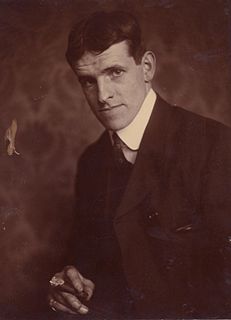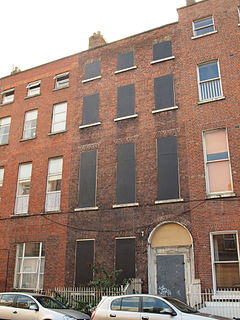The National Literary Society (also known as the Irish National Literary Society) was founded in Dublin in 1892 by William Butler Yeats.
The members first met in John O’Leary's rooms on Mountjoy Square, and later formally at the Rotunda. Its first president was Douglas Hyde. [1] On 25 November 1892 Hyde delivered a lecture to the society on The Necessity for De-Anglicising Ireland, a precursor to the founding of the Gaelic League. [2]

John O'Leary was an Irish republican and a leading Fenian. He studied both law and medicine but did not take a degree and for his involvement in the Irish Republican Brotherhood he was imprisoned in England during the nineteenth century.

Mountjoy Square is a Georgian garden square in Dublin, Ireland, on the north side of the city just under a kilometre from the River Liffey. One of five Georgian squares in Dublin, it was planned and developed in the late 18th century by the Luke Gardiner, 1st Viscount Mountjoy. It was surrounded on all sides by terraced, red-brick Georgian houses. Construction began in the early 1790s and the work was completed in 1818.

Douglas Ross Hyde, known as An Craoibhín Aoibhinn, was an Irish academic, linguist, scholar of the Irish language, politician and diplomat who served as the first President of Ireland from June 1938 to June 1945. He was a leading figure in the Gaelic revival, and the first President of the Gaelic League, one of the most influential cultural organisations in Ireland at the time.
A Book of Irish Verse, designed to publicise the new societies, was published in 1895, edited by Yeats and dedicated "To the Members of the National Literary Society of Dublin and the Irish Literary Society of London." It featured poetry by T. W. Rolleston, Hyde, Katharine Tynan, Lionel Johnson, AE and several others, with notes and an introduction by himself. [3]

Thomas William Hazen Rolleston was an Irish writer, literary figure and translator, known as a poet but publishing over a wide range of literary and political topics. He lived at various times in Killiney in South Dublin, Germany, London and County Wicklow; settling finally in 1908 in Hampstead, London, where he died. His Killiney home, called Secrora, subsequently became the home of tennis player Joshua Pim.

Katharine Tynan was an Irish writer, known mainly for her novels and poetry. After her marriage in 1898 to the English writer and barrister Henry Albert Hinkson (1865–1919) she usually wrote under the name Katharine Tynan Hinkson, or variations thereof. Of their three children, Pamela Hinkson (1900–1982) was also known as a writer.
Lionel Pigot Johnson was an English poet, essayist, and critic.






